Discover 20 hidden attractions, cool sights, and unusual things to do in Quedlinburg (Germany). Don't miss out on these must-see attractions: Quedlinburg Abbey, Bremer Teich, and Stiftskirche St Servatii und Domschatz. Also, be sure to include Blasii Church in your itinerary.
Below, you can find the list of the most amazing places you should visit in Quedlinburg (Saxony-Anhalt).
Table of Contents
Quedlinburg Abbey

Also known as: Stift Quedlinburg
Abbey. Quedlinburg Abbey was a house of secular canonesses in Quedlinburg in what is now Saxony-Anhalt, Germany. It was founded in 936 on the initiative of Saint Mathilda, the widow of the East Frankish King Henry the Fowler, as his memorial. For many centuries it and its abbesses enjoyed great prestige and influence.
Quedlinburg Abbey was an Imperial Estate and one of the approximately forty self-ruling Imperial Abbeys of the Holy Roman Empire. It was disestablished in 1802/3.
Today, the mostly Romanesque buildings are a World Heritage Site of UNESCO. The church, known as Stiftskirche St. Servatius, is used by the Lutheran Evangelical Church in Germany.[1]
Bremer Teich
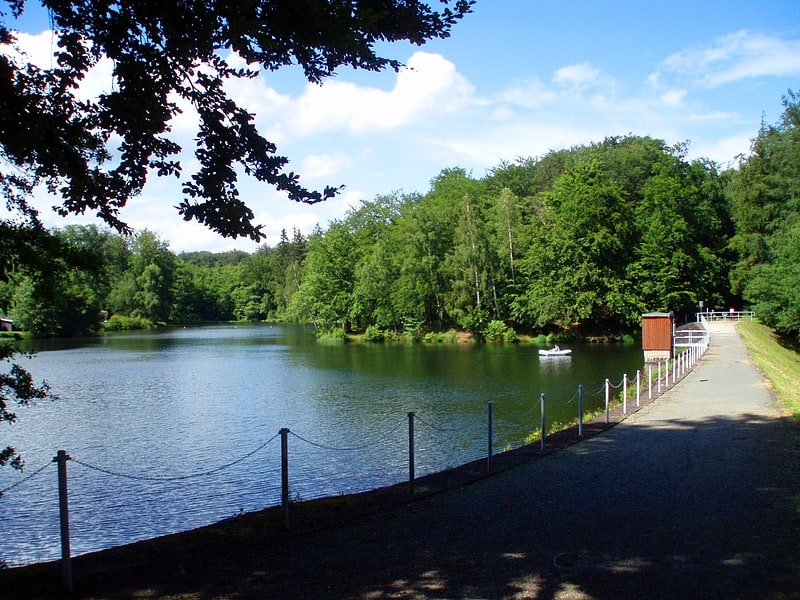
Reservoir in Germany. The Bremer Teich is an historic reservoir that lies south of the two villages of Bad Suderode and Gernrode in the Harz Mountains of Germany, and is used as a recreation area. It impounds the Bremer Graben, an artificial channel fed by water from the Bode and the Saale. The water reservoir was built in the 18th century in the Lower Harz. It has an area of ca. 4 ha. The pond is located on the Romanesque Road and the North Harz Cycleway.
The pond was originally called the Hirschteich ("Stag Pond"). It was laid out in 1796 and was actually intended to trap deer.
In 1696, in the area around the pond, the last bear was killed by the Anhalt prince, Victo Amadeus, whilst he was par force hunting. To commemorate this event the Bear Monument (Bärendenkmal) was erected in 1900.
The Bremer Teich owes its name to the engineer, Bremer, who built the dam. The dam is an earth barrage with internal compaction (Innenverdichtung) In 1968 this was further reinforced by and the pond became the Bremer Dammteich. A youth hostel, camp site and restaurant have been built by the pond.
The Bremer Teich is no. 196 in the system of hiking checkpoints in the Harzer Wandernadel.[2]
Address: Bremer Dammteich 3, 06485 Quedlinburg
Stiftskirche St Servatii und Domschatz
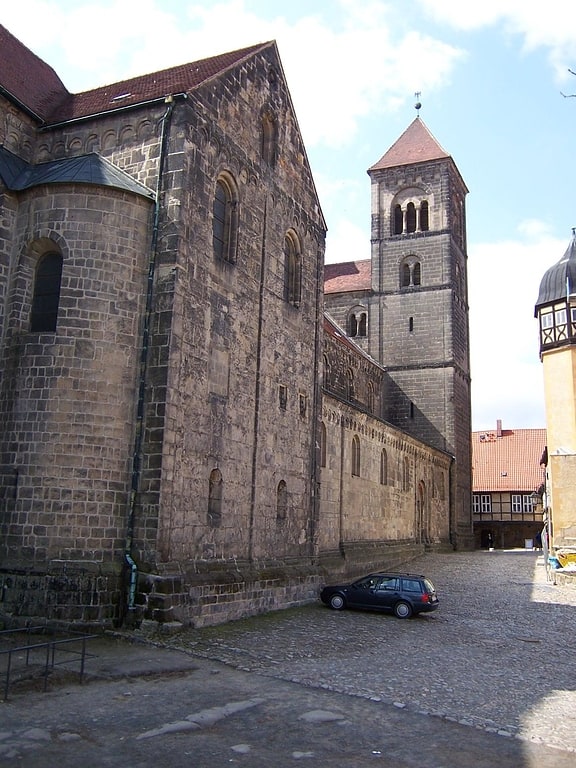
Also known as: Domschatzkammer Quedlinburg#Die Odyssee des Domschatzes
The theft of medieval art from Quedlinburg was perpetrated by United States Army Lieutenant Joe T. Meador in the days prior to the end of World War II in Europe. Precious church objects stored near Quedlinburg, Germany, were found by the U.S. Army. They were placed under guard, but eight extremely valuable objects went missing, including a 9th-century illuminated manuscript gospel book, the Samuhel Evangeliar, and a printed evangeliary dating to 1513, both with jewelled book-covers, as well as reliquaries, an ivory liturgical comb, a perfume-flask made out of rock crystal and other irreplaceable artifacts of historical importance.
The most famous illuminated manuscript associated with the town, the 5th-century Quedlinburg Itala fragment, once in the church, had been moved to a museum in Berlin and was not stolen.
The missing artifacts started resurfacing in 1987. After various lawsuits against and negotiations with the heirs of the by-then deceased Meador, they were restored to their rightful owners. William Honan, an author and journalist working for The New York Times, published in 1997 an account of the theft and how he traced it to the Meador family.[3]
Address: Schloßberg 1, 06484 Quedlinburg
Blasii Church

St. Blasii is a church building in Quedlinburg.
Lyonel-Feininger Galerie

The Lyonel Feininger Gallery is a staff museum in Quedlinburg, founded in 1986. In 2006, it was transferred to the sponsorship of the Moritzburg Foundation - Art Museum of the State of Saxony-Anhalt in Halle and was already included in the Blue Book as a Cultural Memory Site in 2003. As a result, the museum is now one of the cultural beacons in the new German states. The museum has been part of the Saxony-Anhalt Cultural Foundation since 2014.
The museum collection was entered into the local monument register as a movable cultural monument under registration number 094 21194.
Address: Finkenherd 5a, Quedlinburg
Klopstock Museum
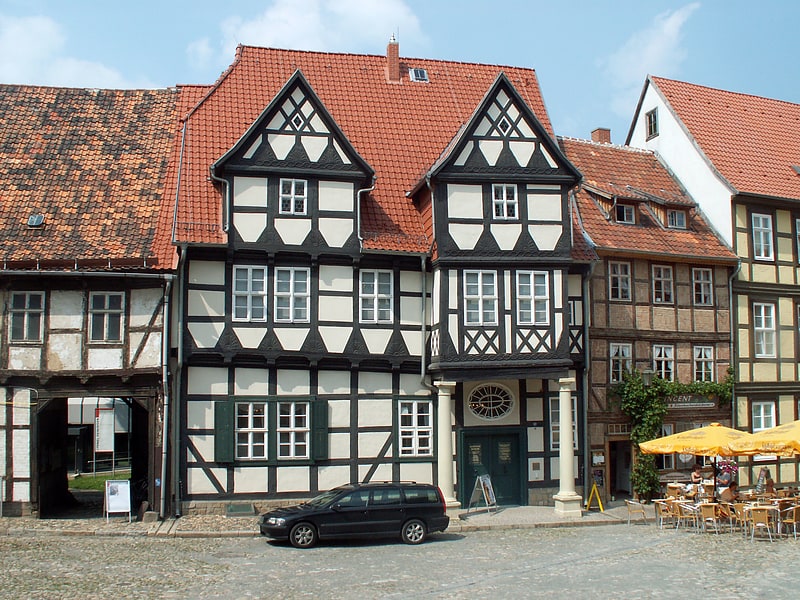
The Klopstock House of the Quedlinburg Municipal Museums is the birthplace of the poet Friedrich Gottlieb Klopstock, one of the founders of classical German literature. In his time he was read more often than his contemporaries Goethe and Schiller. Today, the Klopstock House contains a literature museum, which provides information about Klopstock's life and work, but also about other Quedlinburg personalities. The house is listed in the Quedlinburg register of monuments. Attached to the museum are a library and an archive. The house at Schlossberg 13, which is also a listed building, adjoins directly to the east. At the western end of the garden is the pavilion of the Klopstock House.
Address: Schloßberg 12, 06484 Quedlinburg
Fachwerk Museum Standerbau
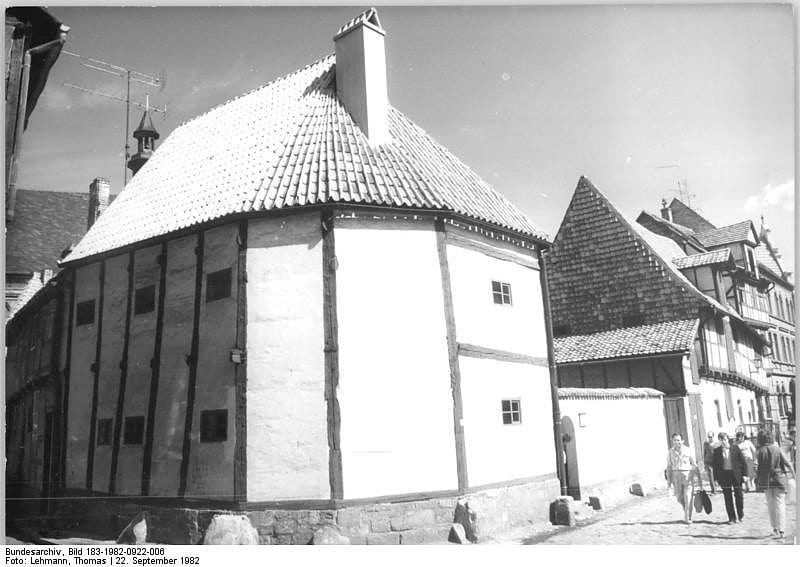
Fachwerkmuseum Ständerbau der Städtischen Museen Quedlinburg is a half-timbered museum and listed half-timbered house in Quedlinburg.
Address: Wordgasse 3, 06484 Quedlinburg
GutsMuths-Haus

The GutsMuths-Haus is a listed building in the town of Quedlinburg in Saxony-Anhalt, Germany. The founder of the German gymnastics movement Johann Christoph Friedrich GutsMuths was born in the building.
The half-timbered house located east of the town's market square at the address Pölle 39 is a UNESCO World Heritage Site.
Address: GutsMuths - Platz, 06484 Quedlinburg
Church of St. Nicholas
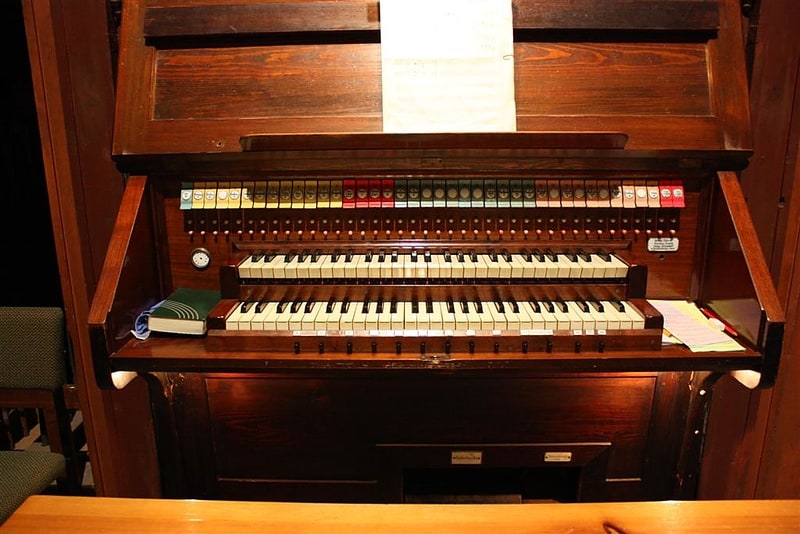
St. Mikołaj - parish church of the New Town in Quedlinburg. Its two 72 meters high towers are still the dominant of the panorama of the city seen from the castle hill. An example of gothic architecture in central Saxony.
A Nowe Miasto settlement was established in the 12th century, located northeast of the Old Town - a former settlement located around the church of St. Benedict needed her own parish. Consequently, in 1222 the construction of the New Town parish began. The original Romanesque basilica was gradually rebuilt in the Gothic spirit, first the western part - a nave body built in the form of a three -nave hall. Then in the fourteenth century a new Gothic presbytery and a monumental Western facade with two multi -storey towers were built. In the 18th century, the church was thoroughly balanced, in 1712 the church received a monumental two -storey main altar and in 1731 the pulpit. In addition, a wooden emporae was erected on the west side, where new organs were erected in 1849. At the beginning of the 20th century there is a thorough renovation of the church. In the 90s of the last century, the windows of the church received stained glass windows made by Ferdinand Mūller.
Address: Neustädter Kirchhof 23, 06484 Quedlinburg
Rathaus Quedlinburg
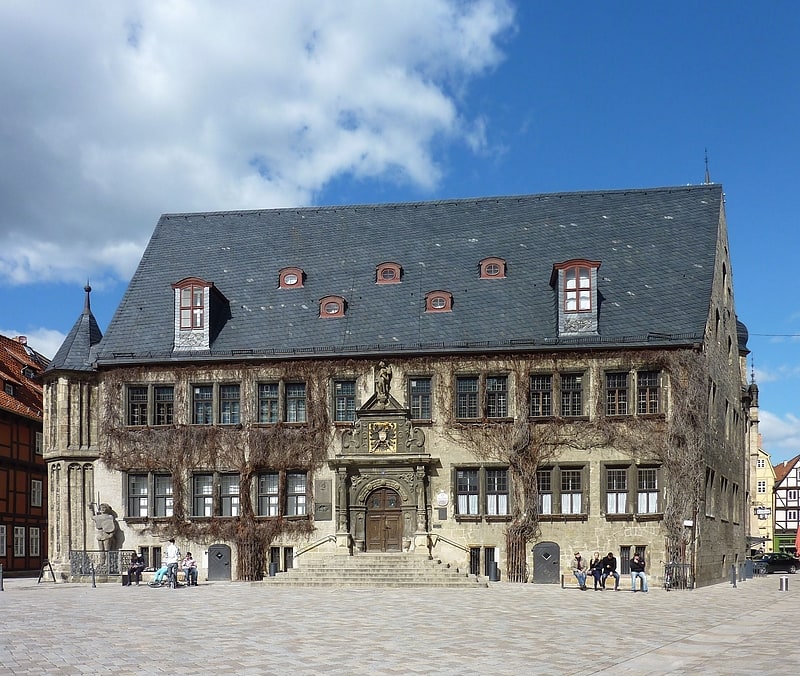
The Town Hall of the Old Town in Quedlinburg is an example of municipal architecture in central Saxony. This building connects: Gothic, late Renaissance, and neo -Baroque styles. It is one of the most important historic Quedlinburg secular buildings.
The first town hall was built here in 1310. In the 15th century it was rebuilt, in 1616-1619 the main entrance was decorated with a monumental portal preceded by stairs, which caused the building to receive a representative character. In 1901, the building was enlarged by an eastern neo -baroque wing to build a new ceremonial room.
It is located at the northern frontage of the Old Town Square. The oldest part is formed by a two -story building covered with a high gable roof enriched with dormers. The compact block of the building, built of the whole stone, has a two-storey tower in the south-east corner. It is decorated with a blind butter, characteristic of gothic facades. The portal is a flanked gate with monumental columns carrying the peak with sculptural decoration. It is created by a cartouche with the city's coat of arms, the figure of Type - the goddess of prosperity, and ornamental decoration characterizing the dusk of the Renaissance and the beginning of the Baroque.
In front of the town hall, next to the corner tower, there is a monumental figure of Roland - the main character of the song about Roland - the historical Count of Breton marchia about which he mentioned in Vita Karoli Magnia Einhard. This late -Gothic work is dated 1427.
Address: Markt 1, 06484 Quedlinburg
Schlossberg
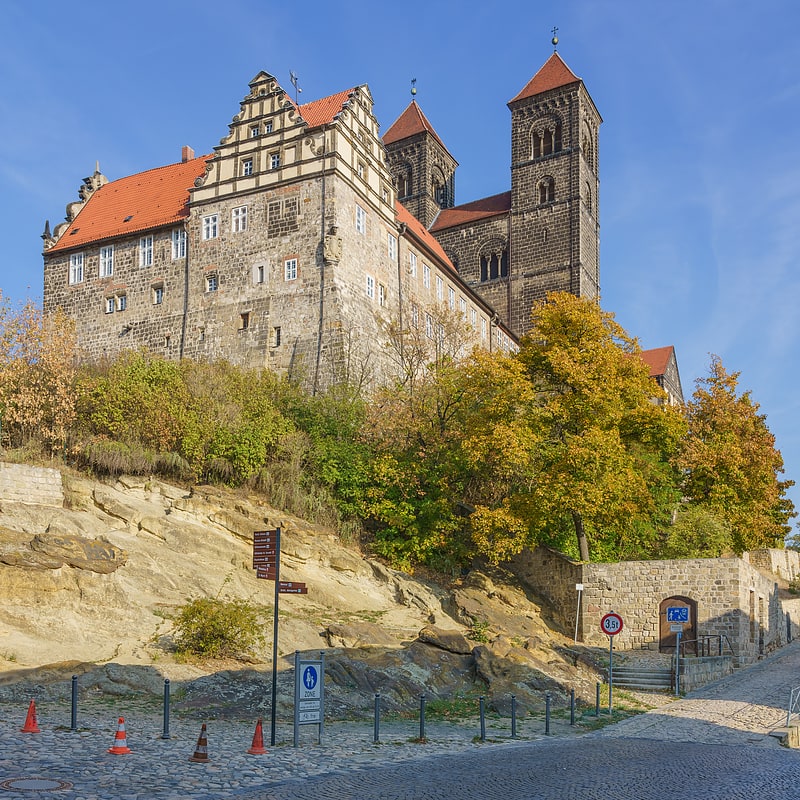
The Schlossberg is an elevation of the Northern Harz foreland. It is located in Quedlinburg in the Harz district of Saxony-Anhalt and is the site of Quedlinburg Abbey.
Address: Brandgasse 1, 06484 Quedlinburg
St. Wiperti
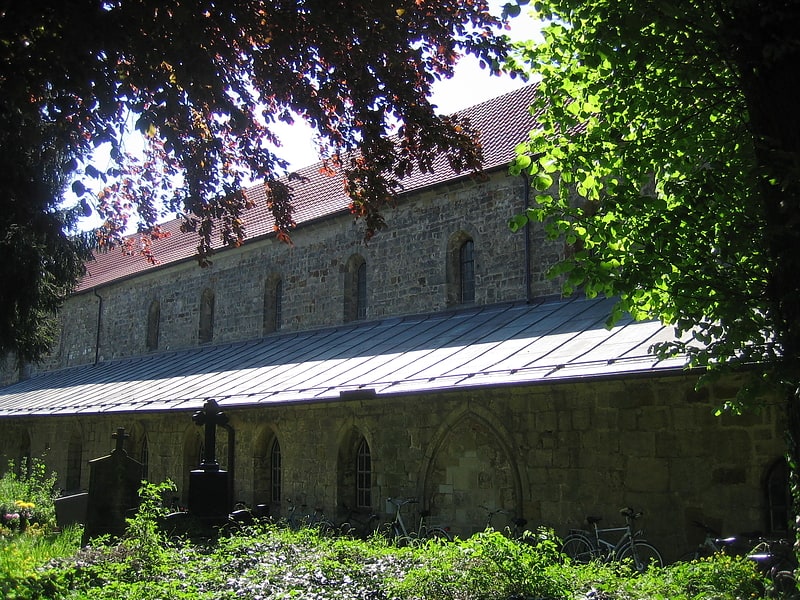
St. Wipeta is located southwest of the castle hill in Quedlinburg. Together with the Collegiate Church of St. Serwacy represents the Romanesque style in this city. Despite the turbulent history, he still kept the oldest remains of early Moman architecture in the city.
Address: Wiperti straße, Quedlinburg
Market Church
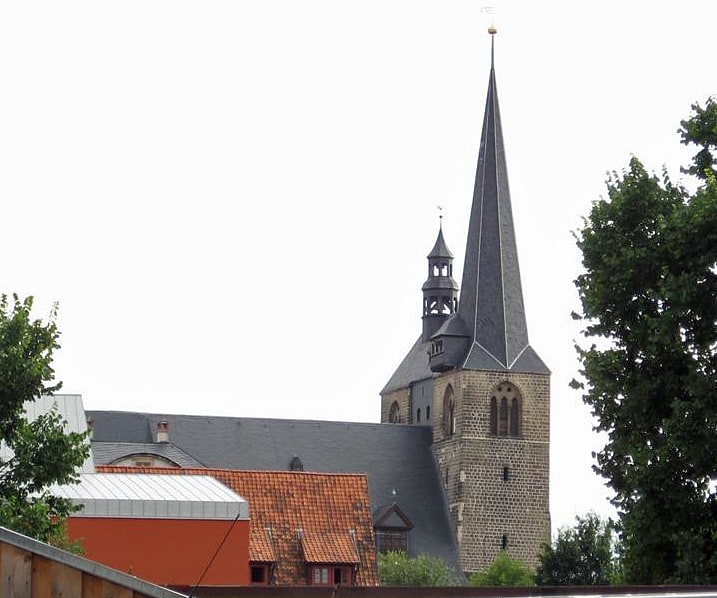
Also known as: Marktkirche
St. Benedict in Quedlinburg, parish church of the city of Quedlinburg, an example of late Roman and Gothic architecture. It is located next to the town hall, next to the city market.
Address: Marktkirchhof 1, 06484 Quedlinburg
Kaiserhof
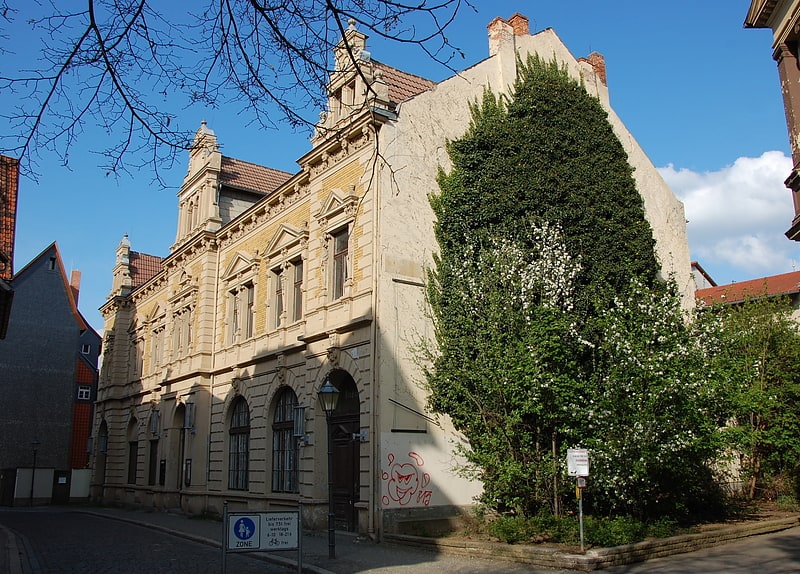
The Kaiserhof is a listed building in the city of Quedlinburg in Saxony-Anhalt, Germany.
Address: 34 Pölle, Quedlinburg
Abteigarten

The Abteigarten is a listed garden in the city of Quedlinburg in Saxony-Anhalt. It is one of the parks of the Garden Dreams of Saxony-Anhalt.
Goetzesches Mausoleum
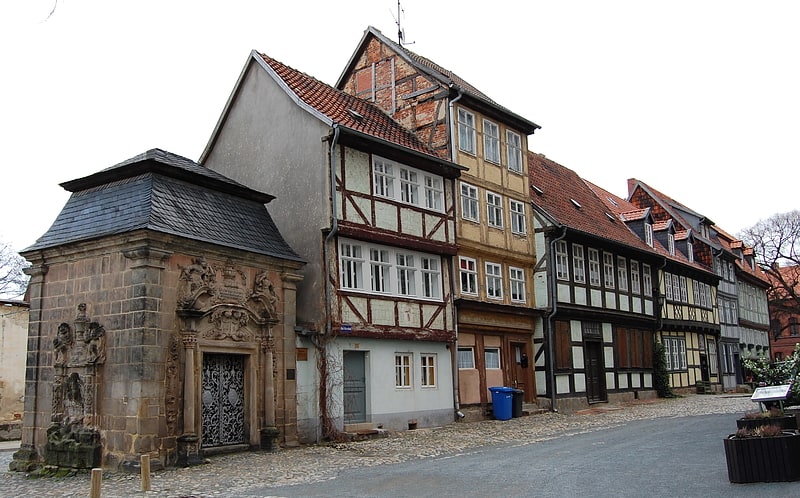
The Goetz Mausoleum, also known as the Gebhardt Crypt or Goetze Crypt, is a listed mausoleum in the old town of Quedlinburg in Saxony-Anhalt, Germany.
The mausoleum is located in the street Marktkirchhof north of the Church of St. Benedict.
St. Aegidii
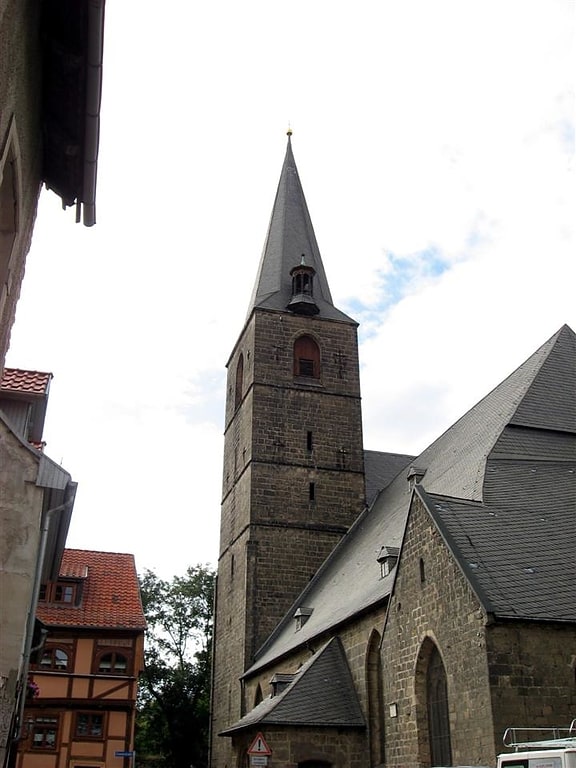
St. Aegidii is a late Gothic church in Quedlinburg. In its present form, it is a three-nave hall church with a southern transept, rectangular choir and west tower.
Address: Ägidiikirchhof 10, 06484 Quedlinburg
Schachtbrunnen
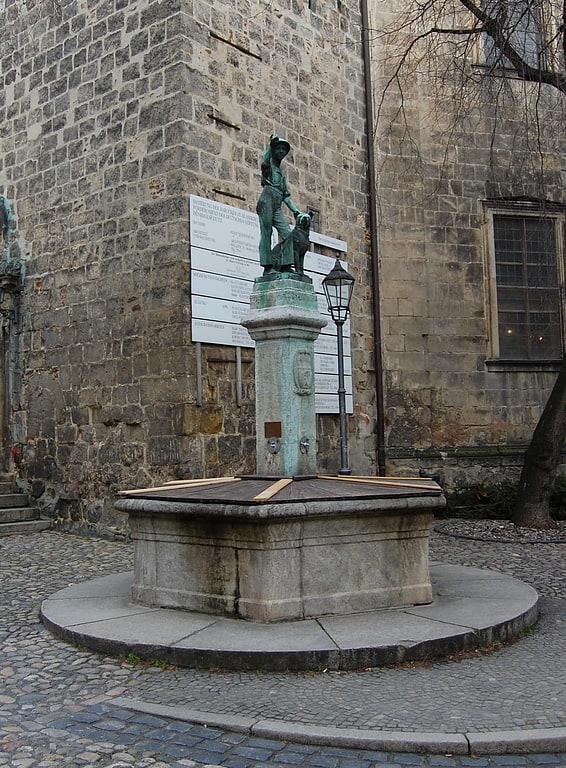
The Schachtbrunnen is a listed fountain named after the merchant Friedrich Schacht in the city of Quedlinburg in Saxony-Anhalt, Germany.
The fountain is located in Blasiistraße west of the city's market square, just in front of the southwest corner of St. Blasii Church.
Sternkiekerturm / Lindenbeinscher Turm
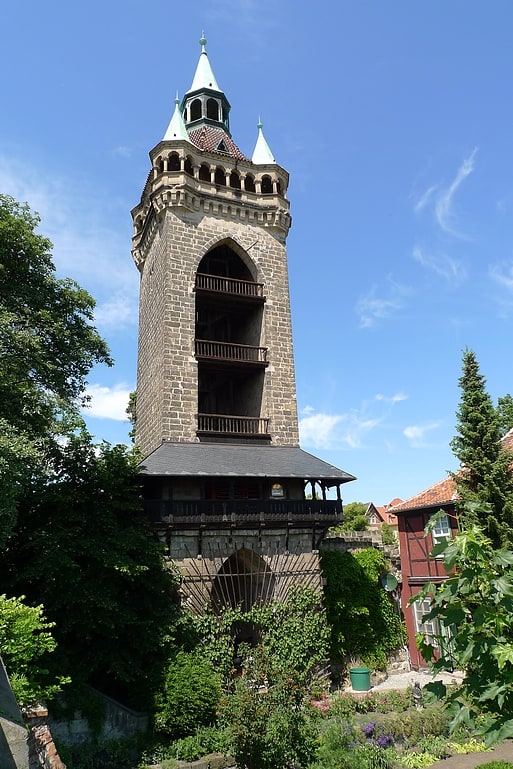
Tower
Johannishain
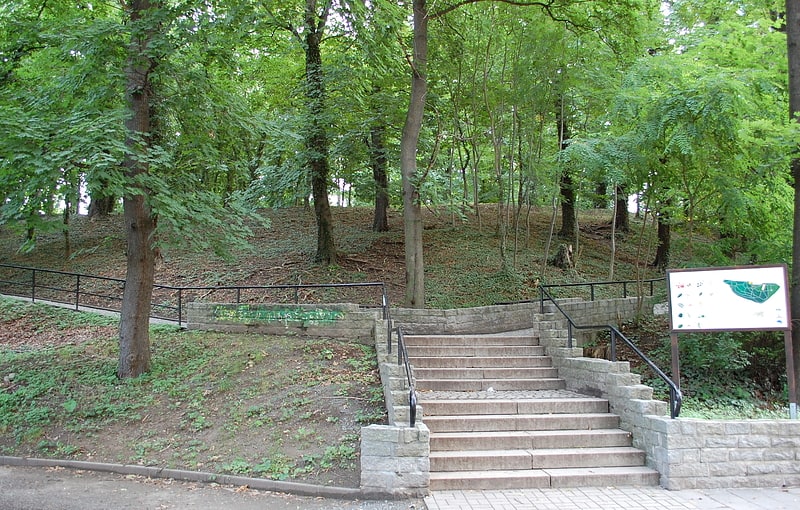
The Johannishain is a park in the city of Quedlinburg in Saxony-Anhalt.